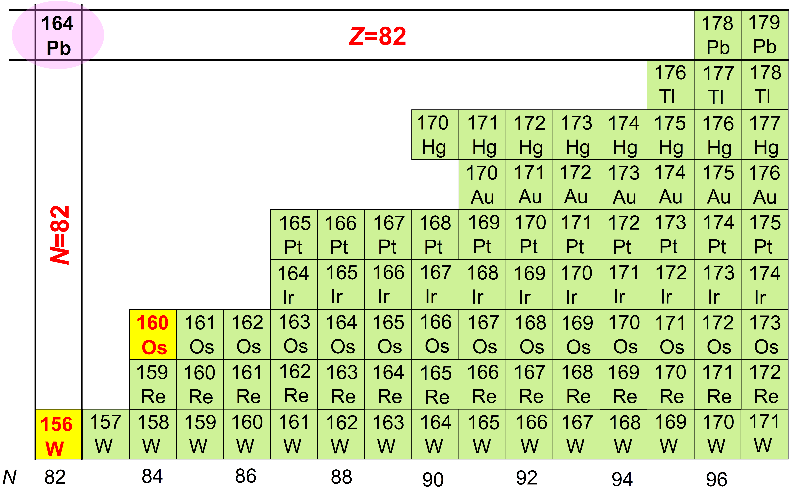The synthesis of two new isotopes, osmium-160 and tungsten-156, by scientists at the Institute of Modern Physics (IMP) of the Chinese Academy of Sciences (CAS) and their collaborators has provided new insights into nuclear structure and raised the possibility that lead-164 could be a doubly magic nucleus with enhanced stability. The study was featured as an Editors’ Suggestion in Physical Review Letters, where it was published.
 Position of the new isotopes, osmium-160 and tungsten-156, on the chart of nuclides. Image Credit: YANG Huabin
Position of the new isotopes, osmium-160 and tungsten-156, on the chart of nuclides. Image Credit: YANG Huabin
An atomic nucleus can become exceptionally stable with “magic numbers” of protons and neutrons. As per custom, the magic numbers that work are 8, 20, 28, 50, 82, and 126. In earlier investigations, scientists found that on the neutron-rich side of the nuclide chart, conventional magic numbers vanished and new ones appeared.
In nuclear areas that are severely lacking in neutrons, would other conventional magic numbers vanish as well? To improve and expand nuclear theories and expand the understanding of nuclear forces, further research is crucial.
The gas-filled recoil separator-Spectrometer for Heavy Atoms and Nuclear Structure (SHANS), housed at the Heavy Ion Research Facility in Lanzhou, China, was used for this study’s experiment.
For the first time, scientists were able to create tungsten-156 and osmium-160 by the fusion evaporation process. They measured the half-life and the energy of α-particles from the α-emitting isotope osmium-160. In the meanwhile, they found that tungsten-156, the daughter nucleus, has a half-life of 291 ms and emits β+.
Researchers calculated the α-decay decreased width for osmium-160 using the recently observed α-decay data and compared it to nuclei that had 84 neutrons but fewer protons. They discovered an unexpected pattern: the decay rate decreases with increasing proton number.
This trend is interpreted as evidence for the strengthening of 82-neutron shell closure towards the proton drip line, which is supported by the increase of the neutron-shell gaps predicted in theoretical models.
Dr. Huabin Yang, Study First Author and Associate Researcher, Institute of Modern Physics, Chinese Academy of Sciences
Furthermore, researchers proposed that the closer proximity to lead-164, a doubly magic nucleus that could have 82 protons and 82 neutrons, might be the cause of the increased stability of the 82-neutron shell closing. Lead-164 is expected to be a bound or quasi-bound nucleus, despite being projected to be beyond the proton-drip line due to the increased shell effect.
The Advanced Energy Science and Technology Guangdong Laboratory, Shandong University, Sun Yat-sen University, Guangxi Normal University, Tongji University, University of Chinese Academy of Sciences, and the Institute of Theoretical Physics of CAS collaborated on the study.
Journal Reference:
Yang, H. B., et. al. (2024). Discovery of New Isotopes 160Os and 156W: Revealing Enhanced Stability of the N=82 Shell Closure on the Neutron-Deficient Side. Physical Review Letters. doi:10.1103/PhysRevLett.132.072502.